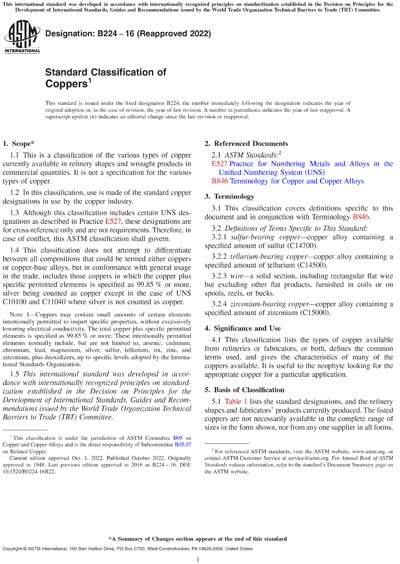Most recent
ASTM B224-16(2022)
Standard Classification of Coppers
1.1This is a classification of the various types of copper currently available in refinery shapes and wrought products in commercial quantities. It is not a specification for the various types of copper.
1.2In this classification, use is made of the standard copper designations in use by the copper industry.
1.3Although this classification includes certain UNS designations as described in Practice E527, these designations are for cross-reference only and are not requirements. Therefore, in case of conflict, this ASTM classification shall govern.
1.4This classification does not attempt to differentiate between all compositions that could be termed either coppers or copper-base alloys, but in conformance with general usage in the trade, includes those coppers in which the copper plus specific permitted elements is specified as 99.85 % or more, silver being counted as copper except in the case of UNS C10100 and C11040 where silver is not counted as copper.
Note 1:Coppers may contain small amounts of certain elements intentionally permitted to impart specific properties, without excessively lowering electrical conductivity. The total copper plus specific permitted elements is specified as 99.85 % or more. These intentionally permitted elements normally include, but are not limited to, arsenic, cadmium, chromium, lead, magnesium, silver, sulfur, tellurium, tin, zinc, and zirconium, plus deoxidizers, up to specific levels adopted by the International Standards Organization.
1.5This international standard was developed in accordance with internationally recognized principles on standardization established in the Decision on Principles for the Development of International Standards, Guides and Recommendations issued by the World Trade Organization Technical Barriers to Trade (TBT) Committee.
ASTM International [astm]

